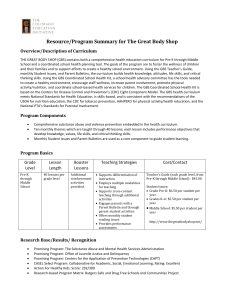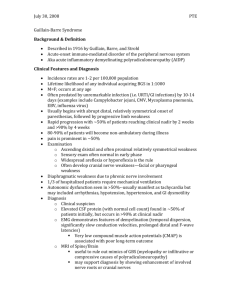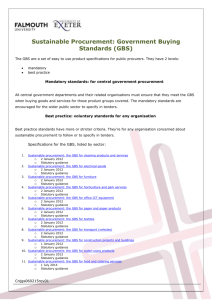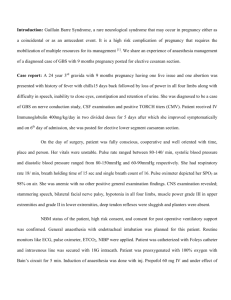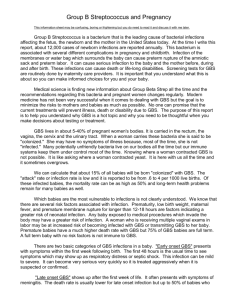Group B Strep in Pregnancy
advertisement
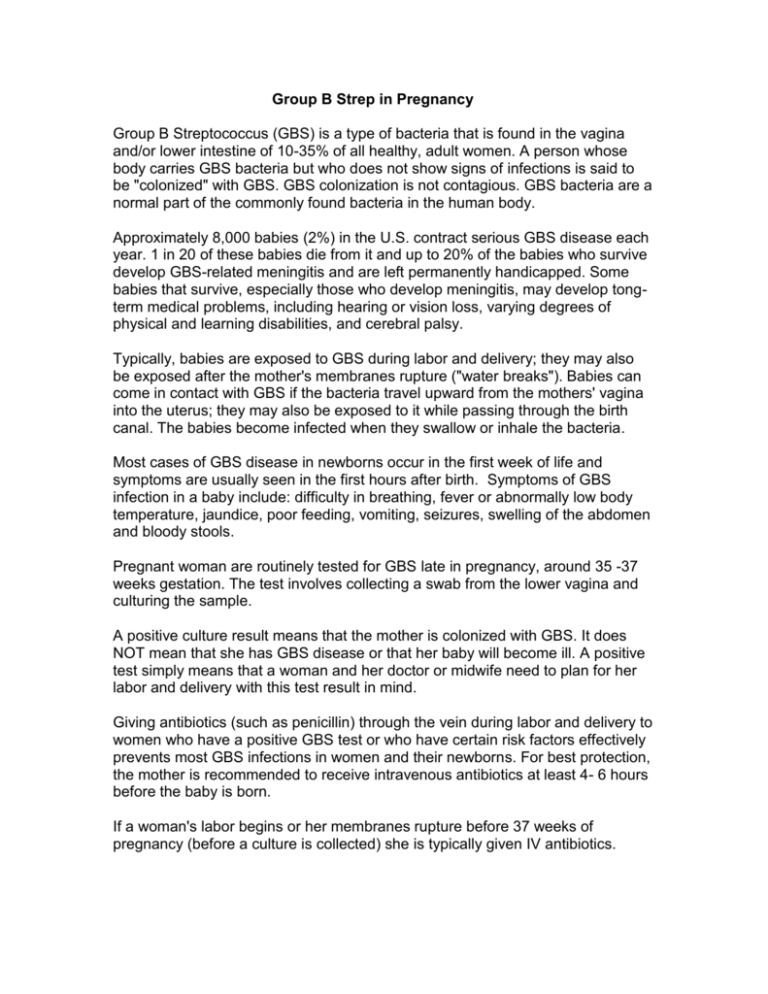
Group B Strep in Pregnancy Group B Streptococcus (GBS) is a type of bacteria that is found in the vagina and/or lower intestine of 10-35% of all healthy, adult women. A person whose body carries GBS bacteria but who does not show signs of infections is said to be "colonized" with GBS. GBS colonization is not contagious. GBS bacteria are a normal part of the commonly found bacteria in the human body. Approximately 8,000 babies (2%) in the U.S. contract serious GBS disease each year. 1 in 20 of these babies die from it and up to 20% of the babies who survive develop GBS-related meningitis and are left permanently handicapped. Some babies that survive, especially those who develop meningitis, may develop tongterm medical problems, including hearing or vision loss, varying degrees of physical and learning disabilities, and cerebral palsy. Typically, babies are exposed to GBS during labor and delivery; they may also be exposed after the mother's membranes rupture ("water breaks"). Babies can come in contact with GBS if the bacteria travel upward from the mothers' vagina into the uterus; they may also be exposed to it while passing through the birth canal. The babies become infected when they swallow or inhale the bacteria. Most cases of GBS disease in newborns occur in the first week of life and symptoms are usually seen in the first hours after birth. Symptoms of GBS infection in a baby include: difficulty in breathing, fever or abnormally low body temperature, jaundice, poor feeding, vomiting, seizures, swelling of the abdomen and bloody stools. Pregnant woman are routinely tested for GBS late in pregnancy, around 35 -37 weeks gestation. The test involves collecting a swab from the lower vagina and culturing the sample. A positive culture result means that the mother is colonized with GBS. It does NOT mean that she has GBS disease or that her baby will become ill. A positive test simply means that a woman and her doctor or midwife need to plan for her labor and delivery with this test result in mind. Giving antibiotics (such as penicillin) through the vein during labor and delivery to women who have a positive GBS test or who have certain risk factors effectively prevents most GBS infections in women and their newborns. For best protection, the mother is recommended to receive intravenous antibiotics at least 4- 6 hours before the baby is born. If a woman's labor begins or her membranes rupture before 37 weeks of pregnancy (before a culture is collected) she is typically given IV antibiotics. Since the antibiotics can cause side effects - the decisions to take antibiotics during labor should balance risks and benefits. If you are allergic to penicillin, consult your doctor to learn about other effective antibiotics. Cesarean sections are not likely to prevent GBS disease. Avoiding GBS Colonization It is not guaranteed that you will avoid GBS colonization if you take the following measures, however, it is possible to eliminate it. The following measures are not intended to replace the use of antibiotics in the event of colonization, but to prevent and kill GBS colonization prior to testing: Creating an Acidic Environment Lactobacilli prefer an acidic environment and they help to promote an acidic environment in the vagina. GBS and yeasts prefer a more alkaline environment. Introducing probiotics is helpful to create a healthy level of acid and to prevent an over-growth of bacteria, GBS, and yeasts. Another benefit of lactobacilli is they have an antibiotic effect on GBS. Probiotic supplementation – You can increase the labtobacilli in your system by taking oral supplements or increasing your intake of cultured foods – yogurt, kefir, kombucha, and other fermented foods. Probiotic Douches - Pregnant women should not use a douche bag or pressurized bag because of the rare danger of air-embolism. A variation that is safe for pregnancy is called Jug douching: the woman sits over the toilet or in a bathtub and pour the liquid over her vulval/vaginal area, "sweeping" it up inside with her hand. Use a mild vinegar solution 1 to 3 Tbsp per pint of warm water. Do this 2 to 3 times daily for a week, then 2X a week, then 1X a week for a few weeks. Another excellent method is to use Hydrogen Peroxide. This is a simple recipe: instill three tablespoons of 3% hydrogen peroxide into the vagina. Leave for 3 minutes and drain. A few tablespoons of plain yogurt can be used as a douche, or a cream, or smeared over a tampon and inserted once a day for 6 hours. Garlic is espoused by midwives (and some obstetricians) to kill GBS. Protocol: Break a clove off of a bulb of garlic and peel off the paper-like cover. Cut in half. Sew a string thru it for easy retrieval. Put a fresh half in your vagina in the evening before you go to sleep. Most women taste garlic in their mouths as soon as it is in their vagina, so it is less pleasant to treat while awake. In the morning, the garlic may come out when you use the restroom. If not, circle the vagina with a finger, till you find it. (or save some trouble and sew a string through the middle of the clove before you put it in.) Most people will taste the garlic as long as it is in there. So if you still taste it, it is probably still in there. Other recommendations: Semen is said to have an antibacterial effect and some recommend having unprotected sex the night before your GBS test. Vitamin C supplementation (preferably from a natural source such as powdered camu camu or powdered acerola). Eat lots of garlic and ginger. Grapefruit seed extract, Do not wear thong underwear. Wipe from front to back,


